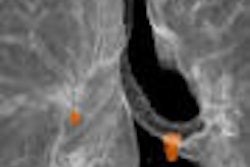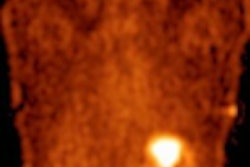Integrated molecular and anatomic imaging with PET/CT technology has been demonstrating superior diagnostic and staging capabilities for various malignancies in a host of current scientific studies. The modality's efficacy in diagnostic imaging no longer seems in doubt; however, the technology comes at a steep price point and models for its economic efficiencies are still being created.
A research team from the departments of medical physics and medical imaging at the Sunnybrook and Women's College Health Sciences Centre in Toronto and the University of Toronto recently examined the cost-effectiveness of FDG-PET/CT in conducting simulations for radiation therapy planning on patients with non-small cell lung cancer (NSCLC). Their work, displayed in a poster presentation at the Society of Nuclear Medicine (SNM) in Toronto last month, found that the modality is more cost-effective than CT in conducting simulations.
"In Canada, PET imaging is currently not funded by the healthcare system and therefore, not commonly used in lung cancer staging, although cost-effectiveness has been shown in this site," the authors wrote.
The researchers tracked 82 patients with NSCLC who had been referred to their facility for radical radiation therapy following conventional (CT) staging. The entire study cohort underwent PET/CT simulation for radiation therapy planning and the resulting images were reviewed by a dual-board-certified nuclear medicine radiologist, as well as the attending radiation oncologist, to determine appropriate patient management.
The authors then compared the cost of delivering radical treatment to the entire study group with the costs of the actual treatments delivered after utilizing PET/CT simulation, which included operating and capital costs.
The researchers listed the following assumptions in their calculations for capital costs:
- The equipment was amortized over a period of 10 years.
- CT simulators at the facility average 12 patients per day, while PET/CT simulators average eight patients per day.
- The institutions linear accelerators average 30 fractions per day.
- The center treats more than 5,000 radiation therapy patients per year.
For operating costs, the group made the following assumptions:
- Collaborative service contracts were for only the planning equipment.
- Physician fees were for delivery of only radiation treatment.
- One full-time equivalent (FTE) physicist, one FTE engineer, and a 0.33 FTE physics technologist were assigned per accelerator.
Overhead was estimated at 35% for both capital and operating costs.
Based on these assumptions the team determined that the cost per patient of CT simulation was $50 Canadian ($40.23 U.S.), PET/CT simulation was $180 ($144.82), radiation therapy planning was $25 ($20.12), and the cost per fraction of the linear accelerator was $30 ($24.15). The facility, they noted, uses 35 fractions for radical therapy and five fractions for palliative therapy.
"The estimated cost per patient for radical therapy was $5,169 ($4,160.54) and for palliative therapy was $1,250 ($1,006.13)," the authors wrote. "At our centre, the cost of adding PET to CT simulation was $1,377 ($1,108.38)."
After the PET/CT simulation imaging, 46 patients received radical radiation therapy and 21 patients received palliative radiation therapy (56% and 26%, respectively). The other 15 patients did not receive radiation therapy, but were treated with an alternate form of management, according to the researchers.
If these 82 patients had not undergone FDG-PET/CT imaging for simulation, the total cost of radical radiation therapy as a result of CT imaging for simulation would have been $423,858 ($341,164.30). As a result of using PET/CT technology, the total cost was $379,233 ($305,242.93) based on 46 radical and 21 palliative treatment courses and PET/CT imaging for all 82 patients -- a savings of $44,625 ($31,919.78), or slightly more than 10%.
"Not only does PET/CT result in a cost-savings to our radiation oncology program, but it also has potential to improve both quality of life and treatment outcome," the authors wrote.
By Jonathan S. Batchelor
AuntMinnie.com staff writer
July 4, 2005
Related Reading
PET/CT improves diagnostic accuracy of unexpected malignancies, June 30, 2005
FDG-PET/CT tops other technologies for lymphoma staging, March 23, 2005
PET/CT planning allows for greater gamble on NSCLC radiotherapy, March 16, 2005
PET/CT demonstrates staging strength over PET, CT, and PET plus CT, March 7, 2005
PET/CT improves detection of metastatic colorectal cancer, December 16, 2004
Copyright © 2005 AuntMinnie.com




















